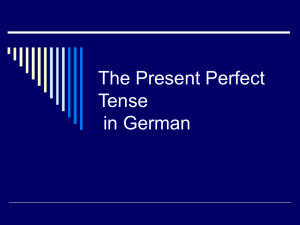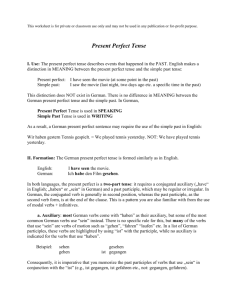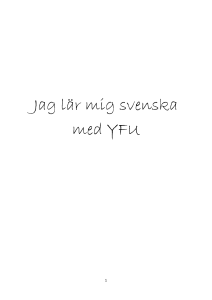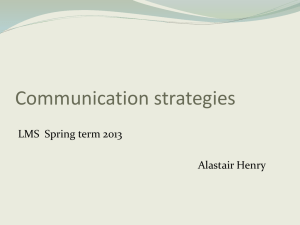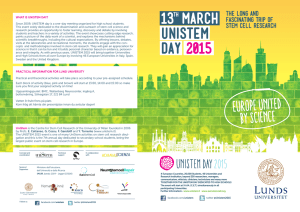CHAPTER FIFTEEN Morphology, Part 2
advertisement
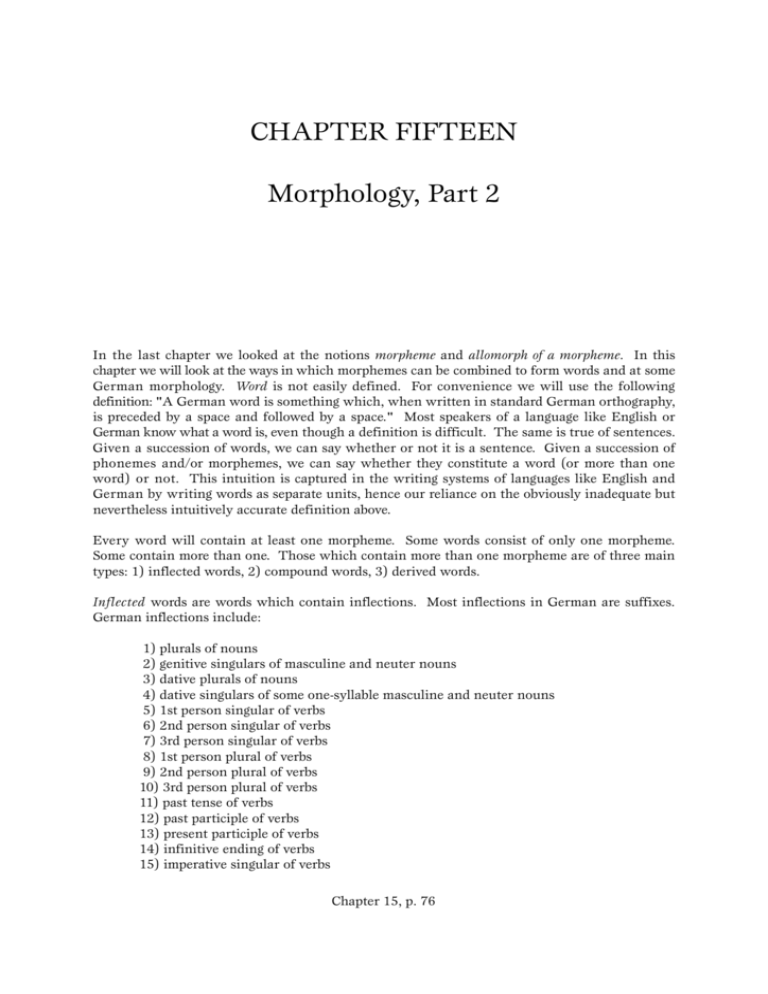
CHAPTER FIFTEEN
Morphology, Part 2
In the last chapter we looked at the notions morpheme and allomorph of a morpheme. In this
chapter we will look at the ways in which morphemes can be combined to form words and at some
German morphology. Word is not easily defined. For convenience we will use the following
definition: "A German word is something which, when written in standard German orthography,
is preceded by a space and followed by a space." Most speakers of a language like English or
German know what a word is, even though a definition is difficult. The same is true of sentences.
Given a succession of words, we can say whether or not it is a sentence. Given a succession of
phonemes and/or morphemes, we can say whether they constitute a word (or more than one
word) or not. This intuition is captured in the writing systems of languages like English and
German by writing words as separate units, hence our reliance on the obviously inadequate but
nevertheless intuitively accurate definition above.
Every word will contain at least one morpheme. Some words consist of only one morpheme.
Some contain more than one. Those which contain more than one morpheme are of three main
types: 1) inflected words, 2) compound words, 3) derived words.
Inflected words are words which contain inflections. Most inflections in German are suffixes.
German inflections include:
1) plurals of nouns
2) genitive singulars of masculine and neuter nouns
3) dative plurals of nouns
4) dative singulars of some one-syllable masculine and neuter nouns
5) 1st person singular of verbs
6) 2nd person singular of verbs
7) 3rd person singular of verbs
8) 1st person plural of verbs
9) 2nd person plural of verbs
10) 3rd person plural of verbs
11) past tense of verbs
12) past participle of verbs
13) present participle of verbs
14) infinitive ending of verbs
15) imperative singular of verbs
Chapter 15, p. 76
16) imperative plural of verbs
17) subjunctive I of verbs
18) subjunctive II of verbs
19) a variety of adjective (including article) endings, blending gender, number and case
20) the comparative of adjectives and adverbs
21) the superlative of adjectives and adverbs
22) case forms of personal pronouns (ich, mir, mich etc.)
Inflections typically give purely grammatical information such as gender, number, person, tense
and grammatical case. As can be seen from the list above, German has a great many inflections.
English, on the other hand, has very few - only eight, in fact. All of the German inflections listed
above have at least one allomorph which is a suffix and only a suffix. Some have replacive
allomorphs as well, sometimes in combination with suffixes. The past participle inflection has
allomorphs which include a prefix /gə-/ as well as a suffix. Occasionally one inflection can be
added to another, e.g. in a word like machtest, where the verb stem /max-/ is followed by the past
tense /-t-/, which in turn is followed by /-əst/, which is second person singular. All German
inflections are bound morphemes. We will return to inflection in more detail later in this
chapter.
Compound and Derived Words
Compound words typically consist of two (or more) stems which are put together to form a larger
word. German is famous for its ability to compound. Usually, although not always, the stems
which are joined together are able to exist as separate words themselves. Thus a word like
Pechvogel "a person who is always having bad luck" is composed of the separate words Pech "bad
luck" and Vogel "bird". On the other hand, Brombeere "blackberry" consists of Brom- /brɔm/,
which does not occur independently, and Beere, "berry", which does. Most compounds are
so-called determinative compounds, where one member, usually the first, determines or defines
(restricts) the second. A Brombeere, for instance, is a particular type of Beere. A Seeadler is a
particular type of Adler. Also typical of determinative compounds is the fact that it is the
determining member which is stressed. Since the determining member is usually the first member,
the first member of compounds is therefore usually the member which bears the primary stress.
One exceptional determinative compound in which the second member is the determiner (and
stressed) is die Muttergottes, a name for the Virgin Mary.
Derived words are, as the name implies, words which are derived from other words. In German
this is ordinarily accomplished by prefixation or suffixation. Often derivational affixes will change
the word class of a word. Gesund, for instance, is an adjective. The derivational suffix -heit
changes adjectives into nouns, resulting, in this instance, in the noun Gesundheit. Other
noun-forming derivational affixes are -ung, -keit, -ling, -nis, -schaft, and -tum, although the latter
two create nouns from nouns. Adjective forming affixes include -ig and -lich. Verbs are frequently
formed from other parts of speech by using prefixes like er-, be- and ver-. All derivational affixes
in German are bound morphemes.
Derived words are themselves candidates for compounding, as are compound words. Let us look
at a typical German compound word - Kreislaufstörungen "circulatory disorders". This is an
inflected noun - note the plural ending -en. Leaving aside the inflectional ending we are left with
Kreislaufstörung, a compound noun which has as its two immediate parts Kreislauf and Störung,
Chapter 15, p. 77
both nouns. Kreislauf is itself a compound noun, consisting of the two nouns Kreis and Lauf1.
Störung is a derived noun, derived from the verb stem {STÖR-} plus the noun-forming
derivational ending -ung. The structure of the word is thus:
Kreis | lauf | stör | ung | en
where the vertical lines indicate morpheme breaks and the lines under the word represent the
hierarchical structure of the word. The hierarchical structure is intended to represent the facts
that Kreis and lauf function together as a unit, although they are separate morphemes, and that stör
and ung, although separate morphemes, also function together as a unit. That is the meaning of
the two sets of brackets in the first line under the word. Then Kreislauf and Störung are
compounded, giving Kreislaufstörung, which then functions as a single unit. That is the meaning
of the bracket in the second line under the word. Finally -en is suffixed to Kreislaufstörung, giving
Kreislaufstörungen. The fact that the suffix is added to the entire word Kreislaufstörung is
indicated by the bracket in the third line under the word.
The structure can also be described in words, e.g.:
KreisLaufKreislaufstör-ung
StörungKreislaufstörung-en
root and stem (noun)
root and stem (noun)
stem (compound noun)
root and stem (verb)
derivational suffix (noun-forming)
stem (derived noun)
stem (compound noun)
inflectional suffix (noun plural)
Sometimes a complex word can have more than one possible analysis. For instance the German
word Unfreundlichkeit could be analysed in either of the following ways:
Un | freund | lich | keit
Un | freund | lich | keit
In the first analysis Unfreundlichkeit is formed by adding the negative prefix un- to the derived
noun Freundlichkeit. In the second analysis the word is formed by adding the noun-forming
derivational suffix -keit to the derived adjective unfreundlich. Both analyses seem to be equally
valid since the words Freundlichkeit and unfreundlich both exist independently in German.
Inflections
Let us now return to inflections and look briefly at some typical German inflectional morphology,
taking the past tense morpheme as an example. We will begin by examining a few present
indicative forms and comparing them with their corresponding past tense forms. We will use 3rd
1
Lauf is probably a noun derived from the verb stem {LAUF-} "run". In the interests of simplicity it will not be so
analysed here.
Chapter 15, p. 78
person plural forms. Therefore each of the verb forms in the following list is to be thought of as
preceded by sie "they". The choice of 3rd person plural is arbitrary - any other verb form would
do as well.
Present
Past
1) machen /'maxən/
2) leben /'lebən/
3) raufen /'raυfən/
4) brummen /'brυmən/
5) reisen /'razən/
6) ahnen /'ɑnən/
7) bellen /'bεlən/
8) mischen /'mʃən/
9) hacken /'hakən/
10) sagen /zɑgən/
11) bangen /'baŋən/
12) führen /'fyrən/
13) mähen /'meən/
14) bluten /'blutən/
15) atmen /'ɑtmən/
16) öffnen /'ûfnən/
17) neiden /'nadən/
18) greifen /'grafən/
19) heißen /'hasən/
20) schließen /'ʃlisən/
21) bieten /'bitən/
22) helfen /'hεlfən/
23) binden /'bndən/
24) werden /'verdən/
25) nehmen /'nemən/
26) heben /'hebən/
27) fahren /'fɑrən/
28) lassen /'lasən/
29) schlafen /'ʃlɑfən/
30) stoßen /'ʃtosən/
31) ziehen /'tsiən/
32) gehen /'geən/
33) stehen /'ʃteən/
34) leiden /'ladən/
35) müssen /'msən/
36) können /'kûnən/
37) brennen /'brεnən/
38) bringen /'brŋən/
machten /'maxtən/
lebten /'leptən/
rauften /'raυftən/
brummten /'brυmtən/
reisten /'rastən/
ahnten /'ɑntən/
bellten /'bεltən/
mischten /'mʃtən/
hackten /'haktən/
sagten /zɑktən/
bangten /baŋtən/
führten /'fyrtən/
mähten /'metən/
bluteten /'blutətən/
atmeten /'ɑtmətən/
öffneten /'ûfnətən/
neideten /'nadətən/
griffen /'grfən/
hießen /'hisən/
schlossen /'ʃlɔsən/
boten /'botən/
halfen /'halfən/
banden /'bandən/
wurden /'vυrdən/
nahmen /nɑmən/
hoben /'hobən/
fuhren /'furən/
ließen /'lisən/
schliefen /'ʃlifən/
stießen /'ʃtisən/
zogen /'tsogən/
gingen /'gŋən/
standen /ʃtandən/
litten /'ltən/
mussten /'mυstən/
konnten /'kɔntən/
brannten /'brantən/
brachten /'braxtən/
These are not all of the possibilities, but they are more than enough to go on with. If we apply the
principles discussed in the previous chapter, it is simple to isolate the recurrent partial /-ən/ as the
3rd person plural morpheme. It occurs in the same form in both present and past tenses. It should
also be clear that all of the allomorphs of the past tense beginning with 18) and continuing through
Chapter 15, p. 79
to the end are morphologically conditioned, i.e. their irregularity is determined by the verb in
question. We will therefore begin with the first seventeen forms.
The first seventeen past tenses are formed in a similar way. A suffix is added to the verb stem and
then /-ən/ is added to that. Comparison of the forms in the present column with those in the past
column allows us to identify two allomorphs of the past tense morpheme: /-t-/ and /-ət-/. What
we now have to determine is their distribution. /-t-/ seems to occur very widely, after both
consonants and vowels. In these examples it occurs after stems ending in /p,f,m,n,l,ʃ,k,x,ŋ,r/ and
/e/. /-ət-/ occurs after stems ending in /t,d,n,m/. There is one bit of overlapping here. Both /-t-/
and /-ət-/ occur after /n,m/ [compare examples 4) and 6) with examples 15) and 16)]. Aside from
these examples /-t-/ and /-ət-/ are in complementary distribution. Complementary distribution
is a criterion for classification into morphemes, just as it is a criterion for phonemes. In fact, /-t-/
and /-ət-/ are in complementary distribution. /-ət-/ occurs after stems ending in /t,d/ and after
stems ending in a combination of an obstruent and a nasal, e.g. /fn, tm/. /-t-/ occurs elsewhere.
In other words, the choice between /-t-/ and /-ət-/ is determined by the immediate phonological
environment and is therefore phonologically conditioned.
The allomorphs of the past tense to be found in examples 18) - 34) are replacives. Usually it is the
vowel which is replaced, while the rest of the stem remains intact, e.g. examples 18) - 30). In
examples 31) - 34) the rest of the stem is altered in some way in addition to the vowel change. In
31) - 33) stems which end in vowels are replaced by stems which end in consonants and which
have different vowels. In 34) the vowel and the stem final consonant are replaced by a different
vowel and a different consonant respectively. Finally we have examples 35) - 38). In 35) - 37) we
have both a replacement of the vowel of the verb stem and also the addition of /-t-/. And in 38)
we have a replacement of the vowel of the verb stem and of the final consonant of the verb stem,
plus the addition of the suffix /-t-/.
Replacives can be indicated in this fashion: /Y <-- (X)/. This is intended to mean that the element
X of the morpheme is replaced by Y, i.e. as "Y replaces X". One allomorph of the past tense in
German could therefore be represented /i <-- (a)/, e.g. lassen, ließen. Leiden, litten would be
indicated /t <-- (ad)/.
As should be clear from examples 2), 5) and 10) above, some "regular" verbs have two different
allomorphs. The distribution of these allomorphs is phonologically conditioned. The allomorph
ending in a voiced obstruent (/b,z,g/ in these examples) alternates with an allomorph ending in
the corresponding voiceless obstruent. The allomorphs ending in voiced obstruents occur before
vowels, the allomorphs ending in voiceless obstruents occur before consonants, e.g. /-t-/. The
voiced-voiceless pair /d,t/ does not participate in this particular alternation since stem-final /d/ in
regular verbs is always followed by the vowel /ə/. Since the alternation of verb stem allomorphs
ending in voiced and voiceless stem-final obstruents is phonologically conditioned, we are not
dealing with replacive allomorphs. Replacives are always morphologically conditioned, i.e. not
predictable from the phonological shape of the morpheme in question and its immediate
phonological environment. The choice between allomorphs ending in a voiced obstruent or in a
voiceless obstruent is phonologically conditioned by the nature of the following sound.
Chapter 15, p. 80
The allomorphs of the past tense which we have isolated (and remember that these are not all of
them) are, then:
1) /-t-/
2) /-ət-/
3) / <-- (a)/
4) /i <-- (a)/
5) /ɔ <-- (i)/
6) /o <-- (i)/
7) /a <-- (ε)/
8) /a <-- ()/
9) /υ <-- (e)/
10) /ɑ <-- (e)/
11) /o <-- (e)/
12) /u <-- (ɑ)/
13) /i <-- (ɑ)/
14) /i <-- (a)/
15) /i <-- (o)/
16) /og <-- (i)/
17) /ŋ <-- (e)/
18) /and <-- (e)/
19) /t <-- (ad)/
20) /υ <-- ()/ + /-t-/
21) /ɔ <-- (û)/ + /-t-/
22) /a <-- (ε)/ + /-t-/
23) /ax <-- (ŋ)/ + /-t-/
e.g. machen, machten
e.g. bluten, bluteten
e.g. greifen, griffen
e.g. heißen, hießen
e.g. schließen, schlossen
e.g. bieten, boten
e.g. helfen, halfen
e.g. binden, banden
e.g. werden, wurden
e.g. nehmen, nahmen
e.g. heben, hoben
e.g. fahren, fuhren
e.g. schlafen, schliefen
e.g. lassen, ließen
e.g. stoßen, stießen
e.g. ziehen, zogen
e.g. gehen, gingen
e.g. stehen, standen
e.g. leiden, litten
e.g. müssen, mussten
e.g. können, konnten
e.g. brennen, brannten
e.g. bringen, brachten
A complete description of German morphology would have to contain a list of the allomorphs of
the past tense in German along with a list of the verbs which occur with each allomorph, insofar
as the allomorphs are morphologically conditioned, i.e. not predictable. Once that list is complete,
the description would state that for all other verbs either /-t-/ or /-ət-/ is added to the stem, the
choice being phonologically conditioned by the final sound sequence of the stem, in that /-ət-/
occurs after stem final /t,d/ and after stem final clusters of obstruent and nasal, and /-t-/ occurs
elsewhere.
We can represent the past tense morpheme as {-T-}. {-T-} serves as a cover term for all
allomorphs of the past tense. Thus we can speak of the allomorph /i <-- (a)/ of {-T-}, or of the
allomorph /-t-/ of {-T-}.
Let us reiterate that the allomorphs of the past tense are in complementary distribution, in that no
two allomorphs occur in the same environment. When we were dealing with phonology and
attempting to group sounds together as allophones of a phoneme we looked for phonetic similarity
and complementary distribution. For instance, [x] and [ç] are phonetically similar in that they are
both voiceless fricatives articulated in the back of the mouth, and they are in complementary
distribution in that [x] occurs only after the back vowels /a,ɑ,ɔ,o,υ,u,aυ/ and [ç] occurs everywhere
else. With morphology we look for sequences which have the same meaning and which are in
complementary distribution. All 23 of the listed allomorphs of {-T-} mean the same thing, and no
two of them occur in the same environment, in our examples. Sometimes we do, however, get two
possible past tense forms for the same verb. For instance the verb senden "send" has two possible
past tenses, sendeten and sandten. The former is allomorph 2), the latter is allomorph 22). Sieden
Chapter 15, p. 81
"boil" has two past tense forms, siedeten and sotten. Obviously these forms are not in
complementary distribution. They are in free variation, just as the allophones [p}], [p] and [p§]
of /p/ are in free variation at the end of the word ab. It is clear what is happening when we get
two past tense forms like these. Forms like sandten or like sotten place a greater burden on the
memory than forms like sendeten and siedeten. There is and has been over the centuries a trend
towards regularisation, towards predictability, towards phonological rather than morphological
conditioning of the choice of allomorphs of a morpheme. When this happens two alternative forms
will co-exist in free variation for a time until eventually (usually) the regular, predictable form
replaces the irregular, unpredictable form. This has happened in both English and German,
although to a lesser extent in German than in English. A glance at a list of principal parts of
irregular verbs in German will show that there are quite a few verbs where the regularisation
process is all but complete, others where it is well underway.
Free variation and complementary distribution are the two types of non-contrastive
distribution. We will therefore revise our definition of morpheme to read as follows: "A
morpheme is a sequence of phonemes with a meaning. Allomorphs of a given morpheme have the
same meaning and occur in non-contrastive distribution."
In this chapter we have further defined the notions morpheme and allomorph and have looked
briefly at a fragment of the system of verbal inflectional morphology in German. It was pointed
out that German makes much greater use of inflection than does English. It should also be clear
that German makes greater use of morphological conditioning of the choice of allomorphs than
does English, which relies to a greater extent on phonological conditioning. We have also looked
very briefly at compounding and derivation as ways of forming new words in German. Both
morphology and word formation are interesting and rewarding fields which deserve more attention
than we can grant them here.
In the next chapter we will look briefly at syntax (how words are put together to form sentences)
and at differences in types of languages, so-called language typology.
Chapter 15, p. 82
